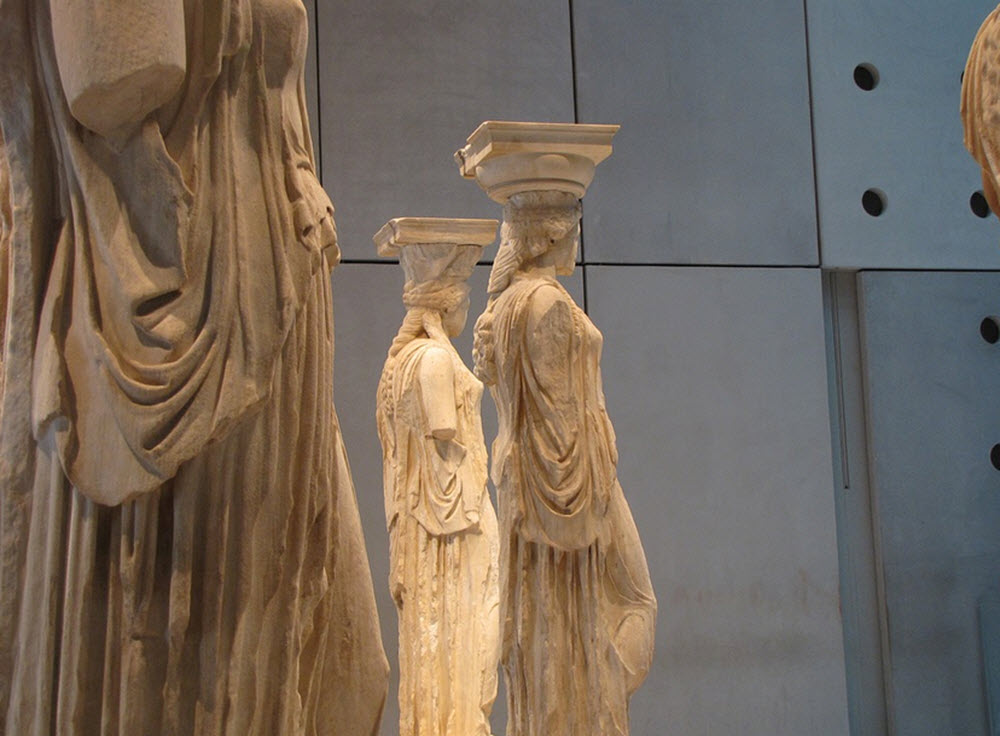The Acropolis Museum (Greek: Μουσείο Ακρόπολης / Mouseio Akropolis) is focused on the archeological findings made at Acropolis in Athens. It is a successor to the old Acropolis Museum in Athens, which was built in the 19th century. The modern Acropolis Museum opened to the public in 2009 and is home to well over 4,000 objects exhibited over an area of 14,000 square meters.
The Acropolis of Athens is an ancient citadel located on a rocky outcrop above the city. It is renowned for its ancient buildings of great architectural and historic significance, the most famous being the Parthenon.
The artifacts in the Acropolis Museum have been found on the rock and on the surrounding slopes. A majority of the objecst are from the Greek Bronze Age, the Roman Era or Byzanthine Athens.
Continous excavations
The museum was built over an ancient road, and is just 280 meters away from Parthenon. As the museum is located right on top of an archeological site, excavations are continously going on below the ground level of the museum, and visitors can watch the process through the glass flooring.
Since June 2019, visitors have also been permitted to walk through an excavation site underneath the building. It is the excavation of an ancient neighbhourhood with artefacts from the Classical era and onward to Byzantine times.
Examples of objects displayed in the museum
- Moschoporos, “The Calf Bearer”, is an ancient Greek statue dated to circa 560 BCE. It was excavated in fragments in the Perserschutt (ceremonial dump) in the Acropolis in Athens in 1864.
- The Blond Kouros’s Head of the Acropolis is the marble head of what was once a complete statue of a young man. It was created around the year 480 BCE. The head, and parts of the pelvis, was discovered on the Acropolis in 192 Originally, the curcly hair was painted yellow.
- The Peplos Kore is a white fine-grained Parian marble statue of a girl, dated to circa 530 BC. It is one of the most famous examples of Archaic Greek art. The statue was discovered on the Erechtheion on Acropolis, in three pieces, in 1886. Kore means girl/young woman and peplos is the type of shawl-like garnment that she is wearing.
- The Kritian Boy was sculptured during the Early Classical period. It was discovered during excavations of the Perserschutt in 1866, and is believed to have been discarded there by Athenians after being partly destroyed by the marauding Persian army in 480 BCE.
- The Parthenon frieze is a high-relief pentelic marble sculpture created between circa 443 and 437 BCE. It was created as an adorment for the Parthenon. The frieze originally spanned 160 meters, but only 128 meters have survived into our time, since part of it was destroyed by Venetian bombardment in the 1600s.
A majority of the surviving frieze is exhibited as part of the Elegin Marlbes in the British Museum in the UK, but you can also see a sizeble part of it in the Acropolis Museum.
Where is the museum?
The museum is built on the southeastern slope of the Acropolis hill, over an ancient road that led up to the sacred rock in classical times. The main entrance to the museum is accessible from Dionysiou Areopagitou Street, not far from the metro station.
Address: Dionysiou Areopagitou Street, Athens, Greece
Coordinates: 37.969108°N 2728299°E
Closest metro station: Akropoli (Line 2/Red)
Origins
The old Acropolis Museum in Athens was opened in 1874 and expanded in the 1950s, but even after the expansion, it wasn’t large enough to house all the new artifacts continously discovered during excavations of the Acropolis in the city.
Another reason to construct a new museum was Greece’s increased efforts to make museums around the world give back artifacts originating from the Acropolis of Athens. The British Museum was for instance very reluctant to return the famous Parthenon Marbles, claiming that the old Acropolis Museum wasn’t fit to preserve and exhibit them.
The first architectual competition to design a new museum was held as early as 1979, but a long series of imbroglios and snarl-ups resulted in three more competitions being held before cosntruction actually started in earnest, and the museum wasn’t ready to receive any artifacts until 2007. Also, the fourth competition had not included any provisions for the preservation of the ancient site, and this was not rectified until both local and international campaigners put sufficient pressure on the Greek authorities.
The moving of artifacts from the old museum building to the new started in October 2007 and was completed in four months.

